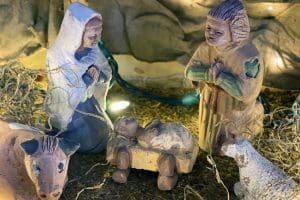![]()
The Sibylline Oracles of Ancient Rome
By Daniel C. Peterson and William J. Hamblin
All ancient societies looked to prophecy and divination to insure that their beliefs and activities were consistent with the will of the gods. Among the Romans, no prophetess was more important or famous than the Sibyl. (The term is not a name, but is the title of a prophetic office always held by a woman.) Throughout the ancient world at different times there were many women who were said to have been Sibyls, including a legendary Jewish Sibyl, the daughter-in-law of Noah who lived at the time of the Tower of Babel. For the Romans, however, the most venerated Sibyl prophesied from a sacred temple-cave at Cumae, near modern Naples.
The appearance of Sibylline oracles in Roman society dates back to the beginning of Roman history. According to legends, King Tarquinius Priscus (early sixth century BC) was approached by an old woman who brought nine scrolls containing the prophecies of the Sibyl, for which she demanded three hundred gold pieces. Tarquinius, thinking the woman a fraud and despising this gift of the gods, refused to pay the outrageous sum. Thereupon the old woman burned three of the scrolls in the nearby fire, turned again to the king and asked three hundred gold pieces for the remaining six. Convinced that the old woman was mad, Tarquinius again refused, upon which the crone burned three more scrolls, again demanding the same three hundred gold pieces for the final three. Realizing that the woman was the Sibyl herself, Tarquinius agreed to pay the sum. The three surviving scrolls of the Sibyl were thereafter carefully preserved in the Capitoline temple of Rome as the most sacred books of the Romans. These oracles were regularly consulted by a body of ten special priests, seeking for prophetic guidance in major policy decisions. However, the Romans always recognized that they lacked the original complete collection of oracles and, consequently, that their interpretations were fallible.
The pagan Sibyl of Cumae was thought to have prophesied under the inspiration of Apollo, the god of divination, whose priestess she was. She continued to prophesy at Cumae for many centuries; collections of her later oracles were added to the original three scrolls of Tarquinius. The most famous description of the oracular method of the Sibyl comes from the Roman national epic, Virgil’s Aeneid (6.35ff). After demanding the sacrifice of seven bulls and seven ewes from the hero Aeneas, the Sibyl entered into an ecstatic state. “As she spoke neither her face nor hue went untransformed, nor did her hair stay neatly bound: her breast heaved, her wild heart grew large with passion. She seemed taller to their eyes, sounding now no longer like a mortal, since she had felt the god’s power breathing near.” Thereupon, under the inspiration of Apollo, she prophesied of the future of Aeneas and Rome.
One would have expected Christians and Jews to reject and denounce this pagan prophetess. And many did so. Other early Christians, however, interpreted some of the Sibylline oracles as inspired prophecies of the coming of Christ-especially Virgil’s fourth Eclogue, which was thought to have been based on a Sibylline oracle. They quoted passages from these oracles to pagans as proof that even the pagans’ own sacred books prophesied of Christ. The Sibyl’s prophecies thus began to be seen by many Christians as having been inspired, at least in part, by the Holy Spirit, and they were quoted by many early Christian apologists and fathers, including St. Augustine. As such, she appears in Michelangelo’s Sistine Chapel murals along with the prophets of the Old Testament.
This Christian acceptance of some of the Sibyl’s prophecies guaranteed their survival, although the extant books of the Sibylline oracles were heavily edited and interpolated by both Christians and Jews. The remarkable history of the Sibyls is recounted in H. W. Parke, Sibyls and Sibylline Prophecy (Routledge, 1988). The surviving fourteen books of Christianized Sibylline oracles have been translated in James Charlesworth, The Old Testament Pseudepigrapha (1983), 1:317-472.

















